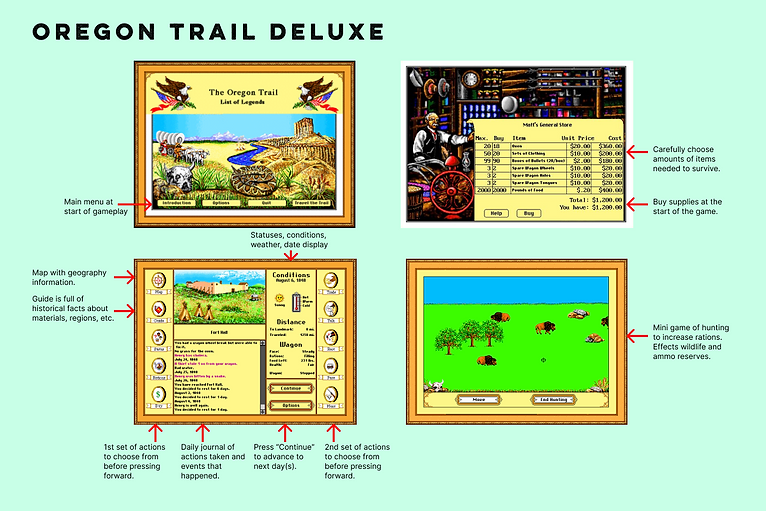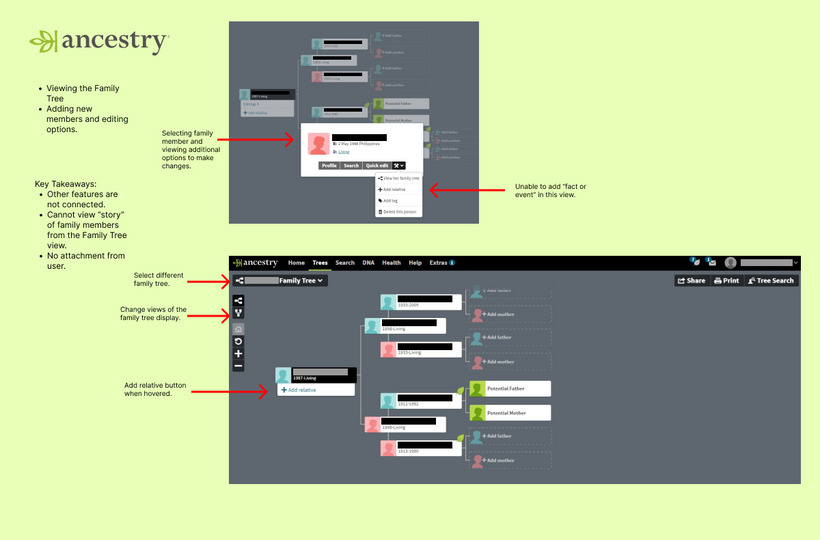

AncestoriesXR
Bringing history and ancestry to life by creating a unique and visually engaging dashboard.
Lead UX Researcher
Lead UI Designer for Dashboard
3 week design sprint
Background
AncestoriesXR is a start-up company striving to reimagine the ancestry industry by combining extended reality and video game interactions to the experience.
Project Brief
Finding the "sweet spot" of this idea to gain customer and investor interest by diving deep into user research and secondary research.
Role & Team
Lead UX researcher and lead UI designer for the dashboard with
Project Lead, Whitney Watts, and UX designer, Reece Holleran.
Research Strategy
Prior to our client meeting, we conducted research on the genealogy industry and extended reality industry to educate ourselves with basic knowledge to understand our client’s service.
We interviewed the CEO and founding partner to learn about their vision, desires, and needs to take their service into the next phase of production. The interview was centered around the following questions:
-
What differentiates AncestoriesXR from other platforms out there?
-
Who is the target audience and how do you plan to scale?
-
What is the main focus and what does success look like for this project?
Afterward, we worked on creating a game plan that would help the client define product requirements and constraints. My team conducted a heuristic evaluation on the existing website which was the only resource provided at the time. I completed the competitive and comparative analysis, created and distributed screener surveys, facilitated user interviews, and moderated usability testings of the website.
Phase 1

Identifying the underlying problem using an affinity map.
Key Quotes from Interviews
"I don't have a good understanding of how this works or what the product does to provide value."
"If I'm submitting the information about my ancestor, how is this going to tell me what I don't already know?"
"How accurate will the storytelling be? I'm confused about how the product will be delivered. What happens next?"
1st Round of Research Deliverables
We focused primarily on genealogy since our client acknowledged Ancestry as her competitor. Click arrows to view
We met with the CEO for our weekly update for a quick recap of the research conducted so far. We received new resources that caused a pivot in our research strategy. I obtained a semi-interactive demo to use for usability testing. The client brought to our attention that this start-up has yet to discover the "sweet spot" in gaining customer and investor interest.
Client Update after Initial Research
"When I meet with investors, they say they don't get it. What is this? They don't see my vision."
"When I show this to younger people, they ask 'Is it like Assasssin's Creed?' I have to clarify that it is not."
"I have the product. I need help figuring out the business and what people are willing to buy."
Diving Deeper
Based on our heuristic evaluation, user interviews, and contextual inquiries of the existing website, it was evident that the vision of the CEO lacked clear illustrations or visuals which left much of her service to the imagination of the potential customers and investors. However, with the semi-interactive demo to test, we began to dive deeper into the videogame industry.
I coordinated the secondary research of storytelling in video games. I selected 3 video games that tie in historical events with engaging interactive gameplay to kick off phase 2 of our research strategy.
Phase 2



These 3 video game titles were chosen because each showcased a unique approach to education via gamification in storytelling and history.
All three games have fairly simple gameplay mechanics while engaging the player to discover clues to learn more about historical events to uncover the mystery of life in the past.
I spent hours playing Oregon Trail Deluxe, What Remains of Edith Finch, and watching walkthroughs of Nancy Drew: Secret of the Old Clock.

Oregon Trail Deluxe is rich with historical facts about life in 1848 inspired by the real-life Oregon Trail. The game interaction involves purchasing materials, transportation, supply management, and decision-making that can lead to in-game life or death. Its weakness is the lack of attachment or sympathy for the protagonist and his family.

What Remains of Edith Finch is a masterpiece of interactive storytelling and mystery. Players explore the main character's abandoned family home to reveal the lives of family members by discovering documents, photos, and belongings inside the home. The menu interface is a family tree notebook to track whose life you visited and relived before they passed away. This menu interface and use of exploring items, photos, and newspapers can be done tastefully and affordably while focusing on storytelling.

Nancy Drew: Secret of the Old Clock has simple interactive gameplay that only requires a mouse to play. As a detective, the player somehow travels back in time and must find clues and solve the mystery to return to her present timeline. We took into account the simplicity of the controls and basic mechanics in gameplay.
Speaking to Experts
Additionally, I consulted with a genealogy expert and a video game graphic designer to gain more insight into how this can be feasible that balances cost, value, and game design work.
2nd Round of Research Deliverables
With a strong focus in storytelling in videogames, we found ways to make engagement and discovery of family history exciting.
Beware the Uncanny Valley
The uncanny valley is a common term that describes the dip in emotional response that happens when we encounter an entity that is almost but not entirely, human. For example, dolls can create discomfort and uneasiness, so they're often used in horror films.
We voiced our concern that customers will want an accurate representation of their ancestors. If realism is too difficult to achieve in-game, we suggested the graphic designer take an indie game approach that emphasizes the stylized appearance of characters.
Identifying the Problems
We narrowed it down to 2 problem statements that pertain to 2 areas of concern: The User and The Client
Problem Statment 1
The user needs a way to collect and experience stories of ancestral history so that she can pass down family history to engage and excite younger generations.
HMWs
1. How might we allow the user to provide stories while maintaining historical accuracy?
2. How might we create an engaging platform that entices younger audiences to explore their ancestry while being simple and intuitive to build stories by older audiences?
3. How might we display these stories for the user to revisit and share with friends and family?
Problem Statment 2
The client needs a visually stunning website that lays out a business blueprint of how this works so that investors buy-in without hesitation or questions.
HMWs
1. How might we redesign the website in a way that provides clarity and value to customers and investors?
2. How might we enhance the visuals and update the content copy to increase user comprehension?
3. How might we create a clear call-to-action to gauge interest from customers and investors?
Next Steps
This concluded our research strategy and provided enough information for our team to begin ideation and design studios. My teammates tackled the 2nd problem statement and focused on the website redesign while I primarily dedicated my time to the 1st problem statement and created a user dashboard.
It was enjoyable allowing the research to dictate the direction the next steps should be during the discovery phase of the design process. While pivots are bound to happen, we embraced it and continued our work. The deliverables we provided were greatly appreciated by our client and brought light to her problem areas to focus on with AncestoriesXR.

View Other Work

Redesigning Eco-Stylist's website in a way to bring personalization to their marketplace and find ways to add value to their customers' experience.






































